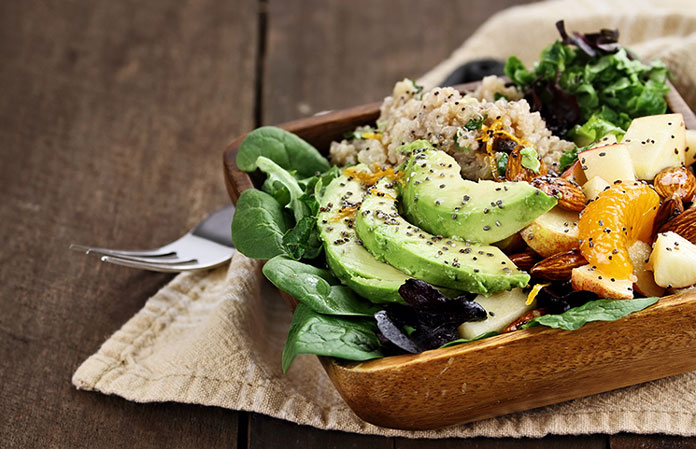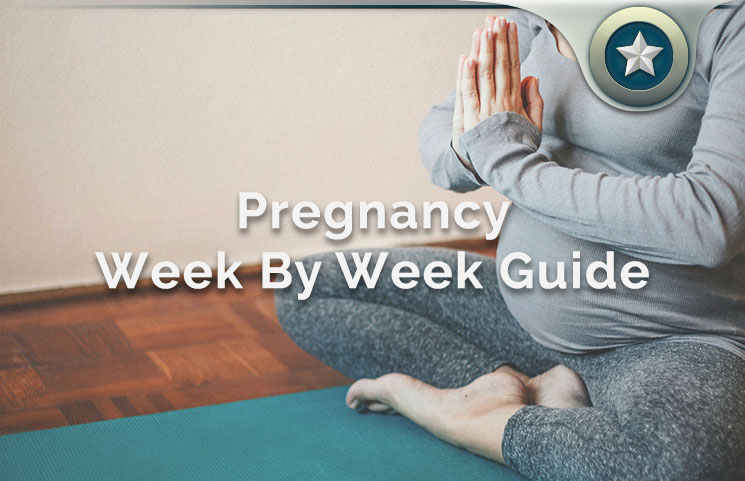If you are trying to get pregnant, especially for the first time, there are things you should know regarding pregnancy. Here is a week by week guide on the progress of a typical pregnancy and what to expect with each passing week.
Pregnancy Week By Week Guide
Week 1
Contrary to what many women think, the first week of your pregnancy starts right from the first day you get your last menstrual period before becoming pregnant. This is because it is included in the weeks of the pregnancy cycle even though at this time your baby is not yet conceived.
You need to watch your health very closely as it will determine your baby’s health. Keep your body in the right condition so that you can carry the full pregnancy to term.
During this first week, make sure you avoid smoking, taking drugs, and consuming alcohol. These substances can lead to respiratory problems, lead to low birth weight, and cause fetal alcohol syndrome, among other health problems.
Let your physician know what prescription and OTC medications that you might be currently taking. Your health care provider should advise you accordingly.
Make sure you add 400 micrograms of folic acid to your diet daily. This is meant to prevent any defect in your baby, particularly spinal defects. Folic acid will keep your unborn baby healthy and help to avoid many health problems.
Do not forget good nutrition and prenatal care. They are essential for your unborn baby. Watch out for pregnancy related symptoms including:
- Missed Menstrual Periods
- Frequent Urination
- Nausea
- Extreme Fatigue
- Headache
- Constipation
- Acid Reflux
- Spotting
Get a pregnancy test and once you confirm you are pregnant, consult a doctor for all important supplements and the required diet. The physician will also help you calculate your due date, which will help you prepare for it. Start low impact exercises like yoga and stretching to keep your body in perfect condition. With your doctor’s instructions, you can also incorporate other light exercises.
Week 2
In the second week, uterine lining will start developing. This helps nourish the baby. Your body will start secreting the follicle-secreting hormone (FSH). You will have completed your menstrual cycle at the end of this week and ovulation will take place. This is when you will conceive. This means that conception occurs at the end of the second week.
The baby’s genetic material is constituted of 46 chromosomes. However, only two of them determine the baby’s sex; one comes from the father, and the other one comes from the mother. They are referred to as the sex chromosomes. An X chromosome from the father produces a baby girl, and a Y chromosome produces a baby boy.
Although all this is going on in your body, you are unlikely to experience any changes in your body. Fourteen days before a period, you experience ovulation. This is where a ripened egg is released from the ovary and travels down the fallopian tube where it meets with the sperm. After intercourse, millions of sperms go through the vagina; hundreds make it into the fallopian tube. However, only one sperm succeeds in fertilizing the egg.
You will have to undergo check-ups regularly in this stage. Consume protein-rich foods and ensure you eat healthy foods that are rich in calcium and iron to ensure you carry the pregnancy to full term.
Although your baby will start developing from the third week, be careful with your diet. Make sure you maintain a healthy required weight in this week to avoid any future complications.
Week 3
This is when your baby starts developing. The fertilized egg undergoes the cell division process. Within the first 30 hours after fertilization, the egg divides into two cells, then four cells, then eight cells, all the way until it gets to the uterus. By the time it reaches the uterus, the egg has evolved into a ball structure referred to as a morula.
The morula then becomes hollow and gets full of fluid, becoming the blastocyst. This process only happens during the third week of your pregnancy. Implantation then happens; this is where the blastocyst gets attached to the endometrium. The work of the endometrium is to provide nourishment to the developing embryo and help it remove wastes. As time goes by, the implantation site develops into the placenta.
Watch your diet during this phase, and be especially careful to get enough iron, folic acid, protein, and calcium. These should be consumed in maximum levels as they will prevent any occurrence of complications in the neural tube. The protein will aid in new tissue creation.
Also, consume a great dose of dairy products. They will help in bone and teeth development. Do not forget to eat a lot of green leafy vegetables and iron as it will help increase the baby’s blood supply volume. Some great sources of iron are red meat, legumes, and green leafy vegetables.
Week 4
At four weeks, the embryo has two cell layers known as the epiblast and the hypoblast layers. This is where the baby’s organs and parts will develop from. During the fourth week, the amnion and yolk sac develops. The amnion is usually full of fluid, and it surrounds the embryo helping to protect it. The work of the yolk sac is to nourish the embryo and also produce blood.
In the fourth week, the baby will further get implanted into the endometrium. The HCG hormone is secreted by the baby, and it helps maintain the uterus lining. The ovary gets signaled to stop releasing any eggs, which leads to missed menstrual cycles.
You may experience slight spotting as the baby is trying to implant properly. Your doctor will measure the HCG hormone during your pregnancy tests. You will experience aching breasts, nausea, and fatigue during this week as the fetus commences growth. These symptoms affirm that the pregnancy is going on well.
You will experience weight gain at this stage which is both healthy and normal. It shows that your baby is growing and the extra weight will get stored for breastfeeding after delivery. Continue to eat wholesome foods as well as dairy products to help with the baby’s growth.
Continue with the regular checkups. Your doctor will let you know what the tests show and clear you of any symptoms.
Week 5
At this stage, the embryo starts to form a distinct shape. The neural tube extending from the brain to the spinal cord becomes fully developed in the embryo. A heart develops as a bulging portion at the center of the embryo. In the fifth week, the placenta develops, and through chorionic villi which are finger like projections, the embryo gets nourishment from the mother.
At this stage, some women will experience nausea and vomiting. Having sore breasts is also normal so do not worry. If you miss the symptoms altogether, this is also fine. However, consult your doctor immediately if suddenly these symptoms disappear after you have started experiencing them.
Stay away from certain foods at this stage as they may lead to food poisoning or even a miscarriage. These foods include:
- Raw Eggs
- Unpasteurized Milk Or Juices
- Soft Cheeses Like Camembert And Blue Cheese
The reason you should avoid them is that some of they can spread food borne diseases. So, avoid or eliminate them from your diet.
If you get a trans-vaginal in the fifth week, it will show 90% of yolk sacs. The baby’s neural folds will begin to fuse at this stage. You can easily differentiate between the head and the tail of your baby at this stage. The baby’s heart also starts beating from week five.
At this stage, your pregnancy diet should comprise of calcium, folic acid supplements, dairy products, and protein. Make periodic checkups to get answers to any queries that you might have about the fetus development.
Week 6
At this time, there is a rapid development of the baby’s brain and nervous system. Its eyes will develop from the optic vessels from the both sides of the head and the passages for its inner ear. You will be able to listen to the baby’s heartbeat through an ultrasound at this stage.
At six weeks, both the digestive and respiratory systems start to develop. The limbs also start to grow. The baby starts to show distinctive physical features, and it is well protected by the amniotic sac.
Since the baby has its legs curled up against the torso during pregnancy, it becomes very hard to do a head to toe measurement, and thus a rump to crown measurement is usually taken. Women complain of morning sickness, fatigue, tender breasts, and heartburn, among other complaints during this week of pregnancy.
Other complaints include hormonal changes, frequent urination, bloating, and water retention. If you can’t handle swallowing prenatal vitamins on their own, have them with your food. You will have to undergo urine and blood tests to ensure that no health issues crop up later.
Get your sugar levels tested and also get checked for urinary infection. You will get a blood test to screen for the Rh factor. This refers to a protein which could turn out positive or negative depending on its content in the blood. At the sixth week, you will also have to go for a Pap smear, blood pressure, and weight check-ups. You can get your first ultrasound, which might be internal.
Week 7
At this stage, the umbilical cord gets formed. It connects you and your baby throughout the entire pregnancy. The baby is rapidly growing and gets oxygen and nourishment through the umbilical cord.
During this week, the baby’s digestive tract and lungs continue to develop. Its ears, nose, and eyes get more defined, and the arm buds develop leading to hands development.
The baby’s reflexes are defined at this stage, making him move speedily. The abdomen and thorax are completely formed, and the lungs start their development at this stage. You will experience numerous body changes at this time, especially the cervix. At seven weeks, the cervix plug gets formed at its opening sealing off the uterus for its protection.
The head becomes more pronounced and presses towards the body. The baby’s ears develop speedily. At seven weeks, the baby opens its mouth and fingers development can be seen. You will experience nausea both during the morning hours and in the evenings.
Try to eat smaller amounts of foods frequently or at night. Morning and evening sickness is more common at this stage so bear with it.
If you experience sciatic nerve pain at this stage, do not panic; it is due to the uterus expansion. Try to do light exercises like walking to keep fit. Continue with the pregnancy diet as per your doctor’s advice.
Week 8
At this stage, toes and fingers start to develop. The baby’s elbows and wrists can also reflex. The baby’s eyes get pigmentation, and its intestines get longer and bulge into the umbilical cord up until the twelfth week of the pregnancy.
The development of the baby’s genitals starts to take shape, though it is impossible to tell the baby’s sex at this stage. All organs get completed at this time, and digestive juices commence flowing. Also, kidneys begin functioning.
The nervous system starts to operate together with the forty muscle sets. The cartilage changes to bone cells. In a baby, there are 140-150 heartbeats every minute. Its eyelids form, and the eyes finally look open.
At this stage, you will experience bloating, increased waist line, and reflux. To remain comfortable, wear loose fitting clothes and eat small meals frequently. If the acid reflux is too much to handle, you can take an antacid. However, always consult your doctor before taking any OTC medicines.
Go for your first prenatal checkup which might include weight, height, BP, and a physical examination. Other lab tests may also be conducted at the eight week check up like cervical and blood tests. Ask your doctor to clear any doubts you may have.
Week 9
This is the time the embryo becomes a fetus. From the crown to rump, the baby is at 13 and 17 millimeters. The embryonic tail then disappears and cartilage and bone formation continues.
Here, the gonads become ovaries in a girl and testes in a boy, although the baby still has no external genitalia. Its nose becomes visible, and it can make a spontaneous movement at week 9.
Mostly, women will notice spotting at this stage which is normal, but in case of excessive bleeding, seek medical assistance. Indigestion and heartburn become common due to hormone levels changing. The remedies to these problems are eating small portions and avoiding lying down immediately after a meal.
For a natural relief, drink a glass of milk. This month marks the peak of morning sickness. You might also experience no sexual desires due to the fluctuating hormones. Symptoms of gum inflammation are also experienced in this month, warranting the need for proper oral care.
It is very important to treat gum infections since they might lead to premature births. Let your dentist know you are pregnant. Continue taking folic acid and dairy products.
Week 10
By this time, the baby is between 27-33 millimeters from crown to rump. It is also almost 4gms. The limbs are fully formed as well as joints, upper lip, and external ear. The external genitalia will appear at this time, too. At ten weeks, the baby can breathe amniotic fluid, urinate, and move actively. However, it is too early for you to feel the movements.
At this stage, constipation is common. Eat a high-fiber diet to avoid this and remember to take a lot of water. The symptoms of morning sickness will have lessened by the tenth month, though you will still experience fatigue and sore breasts.
Increase your calcium intake as the baby may exhaust all of it from your body, leading to osteoporosis later in life. If you experience frequent headaches, opt for natural remedies like balms.
Week 11
The pregnancy starts to show from week 11 as it marks the end of the first trimester. At this stage, the baby’s head is big, almost half of its entire body. The bones begin to harden slightly, and fingers and toes separate fully. Kicking and stretching movements become more pronounced.
The baby is 1-2 inches long and weighs 8 grams at week eleven. The vital internal organs are fully developed. The skulls ossification centers develop and become more solid. The intestines start moving into the abdominal cavity.
Increased weight gain is healthy at this stage. Improved blood flow and hormonal changes might lead to an improved complexion. However, leg cramps might be a pain in the neck at this time. They can be taken care of by consuming more calcium and potassium. You are also likely to experience leukorrhea.
Since back pains increase at this stage, ensure you wear supportive shoes and always bend your knees while lifting heavy objects. The good thing is those earlier symptoms will disappear, and you will have renewed energy. Continue with your pregnancy diet.
Week 12
By the end of this week, the baby is 21/2 inches long and weighs up to 14 grams. Since the digestive system is fully developed, the baby will be able to push the food through its bowels.
It will also be able to urinate since the kidneys have started to function. The amniotic fluid gets changed every three hours to ensure the baby stays in a clean environment. The baby will clench its fist, make facial expressions, and open/close its mouth at this stage. The baby’s hair and nails crop up, and it can be awake and fall asleep.
Chances of a miscarriage decrease drastically after the twelfth month. You will notice that your uterus is bigger. It can expand 500-1000 times when you are pregnant to accommodate the baby and the amniotic fluid. Make sure the baby gets enough nutrients by continuing with your pregnancy diet.
Linear nigra, which is a dark vertical line, appears at the center of your abdomen which fades away on its own after delivery. Reflexes and kicks are more improved. Keep away from bad habits like smoking, drinking, etc. Continue with regular checkups.
Week 13
At this stage, the baby is almost 3 inches long and weighs around 0.7 ounces. The head is still bigger than the rest of its body, and the eyes come close together. Its pancreas starts producing insulin and its bones become harder. The baby will start getting tiny hairs and eyebrows. At this stage, the placenta is fully functional, providing nutrients and oxygen to the baby and carrying carbon dioxide and waste matter from it.
Most women will have stopped experiencing morning sickness and will actually have a heightened appetite. Mostly, pregnancy symptoms at this stage are comprised of stretch marks around the abdomen, hips, and buttocks area. Acid reflux is still a symptom, but luckily you can use antacids. Your breasts will increase in size in preparation for breastfeeding, and breast milk will get produced at this stage.
Week 14
By now, the baby is around 3.2-4.1 inches and weighs around one ounce. Its ears will shift from the neck to the sides of its head, the neck will become more elongated and the chin more defined. All its facial features and unique fingerprints are already in place.
To deal with constipation, eat foods high in fiber and drink more water. You might go through increasing pains as your uterus pushes your internal organs aside, making sleeping a little difficult. If you experience bleeding, consult your doctor to rule out complications and determine the cause.
Week 15
By now, the baby weighs well over two ounces and is over 4 inches long. This is the most enjoyable time of your pregnancy as there is no morning sicknesses or exhaustion. The baby will develop taste buds and may even get hiccups occasionally.
Ensure you eat healthy foods to get a healthy baby. Take warm baths for the twinges and cramps that you might experience.
Week 16
At week 16, your uterus weighs around 8 1/2 ounces, and the placenta is also growing with your body and producing increased amounts of amniotic fluid. The baby at this stage weighs 2.5 ounces. This is the best time to start exercising. This is when the baby develops fine hairs at the top of its head, and its legs continue to grow in length.
Your milk production glands will commence their work at this time. Between the 16th and 20th months is when you will experience the most fetus movements. Learn all the baby development stages and consult your doctor if you have any concerns.
Week 17
At this stage, you will experience increased bumps and flutters, showing that the baby is healthy. Your doctor will continue to measure your blood sugar levels to ensure you don’t develop gestational diabetes.
You will experience back pains which can be dealt with by having a pregnancy massage. Ensure you follow the right pregnancy diet. At this stage, your child can sense sounds as its ears have finally finished being completed. He is comfortable with the sound of your heartbeat and stomach grumbling.
You will notice stretch marks which will fade in time. Drink a lot of water for skin elasticity and avoid constipation.
Week 18
The baby is about 7 inches long weighing 5 1/2 ounces. You may get a regular sonogram. Your baby’s growth will have slowed, but its reflexes are speedily growing.
At 18 weeks you can undergo a test to determine whether your baby has any genetic disorders. The test is safe for the baby. You might experience low blood pressure since your cardiovascular system gets affected by the pregnancy.
Week 19
Your belly is by now getting bigger, and you will need more rest. The baby is very active and jumps about. It also sleeps for around 20 hours every day. If you want to know the sex of the child, you can ask for a scan.
To avoid dizziness and blood pressure complications, try to sleep on your side and always rise slowly. Continue with light exercises as recommended by your doctor.
Week 20
The fetus is speedily growing, and its movements are more acrobatic. At this stage, the baby is half the size it will be at birth. Continue eating foods rich in iron, proteins, and vitamins.
You should have gained 10 pounds, and your doctor will tell you the healthy weight gain so that you can eat healthy foods. Get a pregnancy massage to alleviate the aches. On this week, start thinking about your baby’s delivery as you are halfway there.
Week 21
At this stage, the baby weighs 12 ounces and is 8 1/2 inches long. The baby’s eyelids get completely formed at 21 weeks. Its movements also increase and to ensure maturity of its digestive tract, the baby swallows amniotic fluid as it moves around.
If it is a baby girl, her vagina gets fully formed, although it will continue to grow until she is born. The baby’s movements will be more significant.
Many women develop varicose veins at this stage due to excess weight. Although they mostly occur in the legs, they can also occur in the rectum and vulva. These varicose veins can be made worse by blood flow and the growing uterus. To get relief from leg varicose veins, elevate your legs. The bad thing about these veins is that they might remain even after pregnancy.
Skin breakouts and lower back pains are some of the pregnancy symptoms at the 21st week. Take frequent baths and get pregnancy massages. Enjoy your baby’s movements and speak or talk to it as it can hear sounds.
Week 22
Your baby is 9 inches long and weighs 14 ounces. Though it’s very small, its facial and other features are completely developed. Its skin is still wrinkly, the lips are more defined, the eyes are fully formed, but the iris has no pigmentation.
Plan for childbirth education lessons at this stage to get you prepared. A few women experience pre-term labor at 22 weeks. Most symptoms at this stage include dull backaches, cramping, and lower abdominal pains, among others. You can get a fetal fibronectin test to rule out the risk of premature labor.
Week 23
By now, the baby is almost 1 pound heavy and is 8 inches in length. Your safe weight gain is between 12-15 pounds. Its pancreas continues to develop speedily. The skin is still wrinkly as it has not gained enough weight.
Expect to experience fatigue, tiredness, and feet swelling. Also, many women will suffer from urinary tract infections while some develop mood swings and depression at this stage. Reduce your salt intake to avoid water retention which leads to swollen feet.
Week 24
At week 24, the fundus reaches over your navel. The baby weighs 595 grams and is 11.8 inches long. It is almost fully formed. As a mother, you will appear more exhausted.
Keep yourself fully hydrated to avoid premature labor. You will experience frequent urination, heartburn, backaches, etc. You will also experience a tightening of your uterus occasionally, which is normal.
Week 25
At this stage, you will experience frequent pains in unusual places like your groin due to the added pressure from the baby. Try and sleep on your side as you might have trouble falling asleep. The cramping you experience might be caused by changes in your circulation or the pressure on nerves.
You will have symptoms like indigestion, frequent urination, and itchy skin. Continue with the pregnancy diet and start moderate exercises that will help ease the delivery process.
Week 26
By now, your baby can hear both you and your husbands’ voices. It can also inhale and exhale tiny amounts of amniotic fluid that is beneficial for its lung development. The breathing movements will be beneficial to him when he finally takes his first breath of fresh air. He now weighs 1 pound and 2/3 and is 14 inches long. If the baby is male, his testicles will begin to descend into his scrotum.
Consume lots of fresh fruits and vegetables as part of your pregnancy diet. Some women might experience a slightly high blood pressure. Others might experience high protein and blood in their urine. Swelling and back pains are also some of the symptoms at this stage.
Week 27
This marks the start of your third and last trimester. Your baby’s retina gets its normal layers, and it weighs more than 2 pounds and 14.5 inches long.
You will require 300-350 extra calories daily. You will continuously gain weight until you hit 36 or 37 weeks of pregnancy. Do not think about losing weight at this time.
You will also experience shortness of breath. Maintain a balanced pregnancy diet.
Week 28
Your baby is 14 1/4 inches and weighs 2.5 pounds. Its brain has developed grooves, and indentions and brain tissue start to increase. The hair on its head grows longer, and it starts looking rounder due to fat storage.
Week 29
By now the baby weighs 2 3/4 pounds and is 14 1/2 inches long. Its muscles and lungs mature as it continues to grow in size. Pregnancy symptoms are the same: insomnia, constipation, and abdominal pain. Continue with the pregnancy diet up to the end. At this stage, you should go for checkups every fortnight.
Week 30
The baby hits 3 pounds and is 10.8 inches. It has a layer of fat to keep it warm, and it occasionally gets hiccups. At this stage, bending becomes a tussle and symptoms remain the same. Try and do light exercises like walking.

Week 31
The baby is now more than 3 pounds and you will appear very exhausted due to the strain. You will have hip, and lower back pains and your breathing will be shallow since your lungs cannot fully expand. You will be able to differentiate your baby’s arms, legs, and head movements.
Even if you get a premature birth, your baby will have a god chance of survival since it has fully developed lungs. It can recognize your voice, and its fingernails have grown. Get a pregnancy massage to relieve the aches and adhere to the pregnancy diet while drinking lots of water.
Week 32
Your baby will have lost nearly all lanugo hair; only a few strands remain on its back and shoulders. It now weighs 4 pounds and is 11.4 inches long. Get checked constantly for BP, urine, and any swelling that may occur as it could be a sign of preeclampsia. Your baby has now taken the head down position.
You will notice a whitish fluid leaking from your breasts. It is colostrums meant to nourish the newborn.
Week 33
Your due date is fast approaching, and you may experience false contractions; they help prepare your body for the actual labor. Your baby is now 4 pounds 8 ounces and is 12 inches. Its skin goes from red to pink, and it starts to store iron in its liver in preparation for the outside world. It can listen to your voice and other sounds in your body. Buy baby items at this time, as the baby might come anytime now.
Week 34
The baby muscles are maturing, and it can finally hold its head up or turn it. It will also be able to stretch its limbs. Its eyes can open while awake and close while asleep. It is now almost 5 pounds and is 12.8 inches. All lanugo hair has been replaced by vernix hair. Look out for premature labor signs. Decide on the hospital where you want to deliver.
Week 35
The baby is 5 1/2 pounds and 20 inches long and is almost fully grown. It will continue to accumulate fat at a high rate of 15%. This rate increases to 30% just before birth, making your baby chubby and plump.
Its brain power continues to increase speedily. Its skull is still soft to help it squeeze through the birth canal easily. Maintain a healthy diet and consult your doctor in case of any complications.
Week 36
The baby is between 5 3/4 to 6 3/4 pounds and 16-19 inches long. It will have dropped lower in the abdomen with the head down position getting ready for birth. It has gained weight considerably to help regulate its body temperature and develop immunity to survive in the outside world.
Consume up to 2,500 calories daily as your body needs the extra calories in preparation for delivery. At 36 weeks, your baby is now fully developed and ready to be born. Prepare to welcome your baby into this world after a long and wonderful journey of the gestation period.
Pregnancy Week By Week Guide Conclusion
If you have not yet given birth, weeks 37-40 will look much the same as week 36. If you have not yet given birth by week 40, your physician should speak to you at this point about medical options to induce labor, perform a C section, etc. What matters at this stage is not so much exactly when your baby is born and more that it is born safely and is healthy.
Keep in mind that the details and specifics of each pregnancy are different. Your baby’s size, your symptoms, and your needs may vary from the exact outlines in this article. It is important to stay in touch with your doctor and follow their directions as closely as possible, as they will be the best source for tracking your pregnancy needs as an individual as well as the individual needs of your baby.
They will also be able to help educate you on the many different options for who to deal with your pregnancy, the style of birth that is best for you, and how to care for your baby after it is born.









